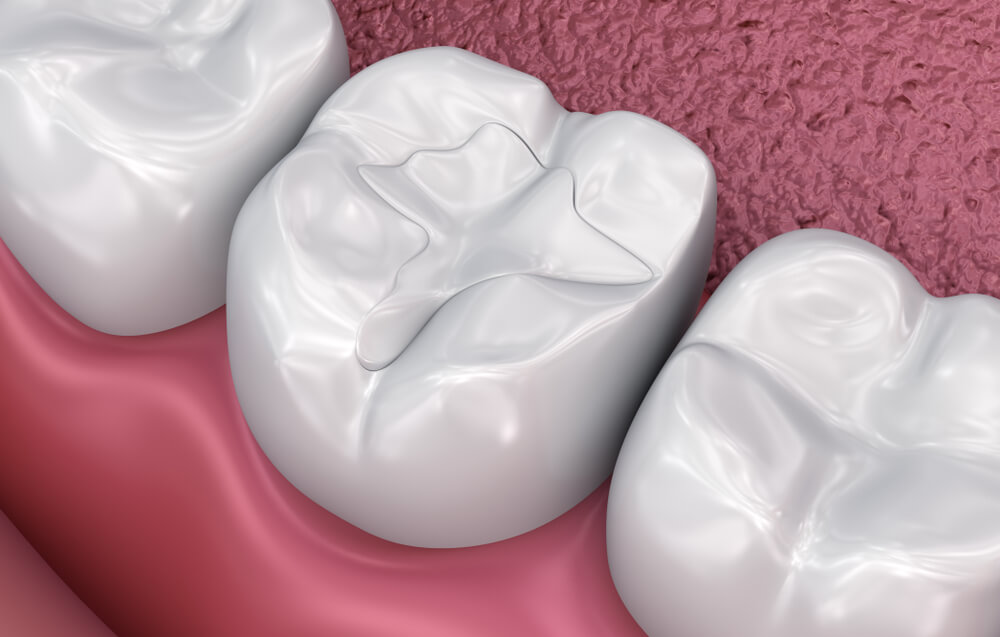A composite filling is tooth-colored dental composite resin that is used to fill in small to medium cavities. Because of their coloring, they are sometimes also referred to as tooth-colored or white fillings. Since they are made from composite resin, they are able to be custom matched to the existing tooth color and are essentially invisible once placed. For this reason, many dentists recommend composite fillings, especially for teeth that are immediately visible when smiling or speaking.
Composite fillings offer many benefits including:
- Their ability to blend in with the surrounding tooth structure and adjacent teeth
- Bonds to the surface of your tooth, which means less drilling and less removal of existing tooth structure
- Highly versatile and can repair damaged or worn teeth
Did You Know?
When your teeth start to decay, some of the enamel is lost. The loss of tooth enamel causes tooth sensitivity, which is usually exhibited as pain when eating or drinking anything too hot, too cold, or with too much sugar. After having a composite filling placed, tooth sensitivity usually subsides and the tooth is restored to its previous healthy state.
Frequently Asked Questions:
Am I a candidate for a composite filling?
You may be a candidate for a composite filling if you have a small to medium cavity that requires a filling. Composite fillings can also be used to restore minor tooth damage such as small cracks or chips. Composite fillings are especially ideal for fillings or damage repair in teeth that are visible when smiling or speaking. To find out if a composite filling is the best choice for you, schedule a consultation with Dr. Kevin H. Speer of Oak Grove Dental Center today!
How do composite fillings compare to amalgam fillings?

There are two main types of fillings used by dentists: composite and amalgam. While composite fillings are made up of composite resin, amalgam fillings are composed of metal. Although commonly called “silver fillings,” amalgam fillings are actually composed of multiple metals including mercury, silver, tin, and copper. This particular mix of metals stabilizes the mercury and allows it to be used safely. At a glance, here’s how these two types of dental fillings compare:
Composite Fillings vs. Amalgam Fillings:
| Pros | Cons | |
| Composite |
|
|
| Amalgam |
|
|
What can I expect when having a composite filling placed at Oak Grove Dental Center?
Before beginning the filling placement process, Dr. Speer will anesthetize your mouth to keep you comfortable during the procedure. In some cases, dental sedation may also be offered to keep you relaxed or still. A dental dam will also be placed to isolate the affected tooth from the rest of the mouth. The placement of a dental dam is an important part of the composite filling process because it prevents saliva from affecting the bonding of the composite resin.

Once your mouth has been anesthetized and the dental dam is in place, your tooth will be prepared for the placement of a composite filling. Preparing your tooth for a dental filling consists of first removing the decayed tissue, cleansing the affected area, and then shaping the cavity for the filling. With composite fillings, there is often not much shaping that needs to be done and the majority of prep work is simply drilling out decayed tissue and cleaning the remaining cavity.
The remaining cavity will then be layered with composite resin until filled. Each individual layer of composite resin must be hardened in place with a special curing light before the next layer can be applied. For this reason, composite fillings take slightly longer to place than other types of fillings. Once the final layer has been applied and hardened into place, the final product will be shaped accordingly.
Will I need to follow any special guidelines after having a composite filling placed?
After having your composite filling placed, you won’t have to follow any special guidelines other than waiting for your mouth to regain feeling before eating or drinking. Because your composite filling is completely hardened during the procedure, it does not require any downtime and is immediately able to be used.
How do I take care of my composite filling?

You will take care of your composite filling much like you would your natural teeth. This means brushing twice daily with fluoridated toothpaste and daily flossing. You will also want to visit Oak Grove Dental Center at least once every six months for your routine dental checkups and professional teeth cleanings. Routine dental checkups ensure that your composite filling can be monitored for any signs of damage or wear.
To protect your composite filling from becoming damaged, you will also want to avoid damaging behaviors like chewing ice, nail biting, and using your teeth as an opener. Individuals who play sports or who grind their teeth may also want to get a bite guard to prevent the filling from premature wear.
How long do composite fillings last?
If properly taken care of, composite fillings can last about 5-7 years. However the lifespan of your composite filling will depend upon how well you take care of it and its location in the mouth. Composite fillings towards the back of the mouth or in areas that absorb more chewing force are likely to wear out sooner. Additionally, teeth grinding or clenching can cause composite fillings to become quickly worn or even damaged.
When your composite filling begins to show signs of wear, it will need to be replaced. In some cases, your composite filling may be able to be repaired instead of completely replaced. Dr. Speer will check for signs of wear at your routine dental exams. Possible signs that you may need to have your filling replaced include tooth sensitivity, a crack in the filling, or noticing that a part of the filling is missing.
How much do composite fillings cost?
Composite fillings are approximately $135-$325 per filling. The total cost of a composite filling will depend upon the size of the filling, amount of composite used, and the location of the affected tooth.
Dental insurance companies will generally classify composite fillings as restorative treatments and offer partial coverage for their cost. However some dental insurance plans will only cover the cost of an amalgam filling and require you to pay the difference. Some dental insurance plans will not provide coverage for composite fillings used on molars. Our office can help you to determine your level of coverage prior to receiving any treatment.
At Oak Grove Dental Center, we believe that providing high quality dentistry is only part of creating a successful relationship with our patients. To experience some of the best dental care in Milwaukie, schedule a consultation with Dr. Kevin H. Speer today!


